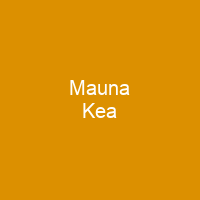Mauna Kea is a dormant volcano on the island of Hawai’i. Its peak is 4,207. 3 m above sea level, making it the highest point in the state. When measured from its underwater base, it is the tallest mountain in the world. The volcano continues to slip and flatten under its own weight at a rate of less than 0. 2 mm per year.
About Mauna Kea in brief

The peak is about 38 m higher than its more massive neighbor. It has an alpine climate at its summit, a Sophora chrysophylla–Myoporum sandwicense forest on its flanks, and an Acacia koa–Metrosideros polymorpha forest, now mostly cleared by the former sugar industry, at its base. In Hawaiian religion, the peaks of the island are sacred. An ancient law allowed only high-ranking ali’i to visit its peak. The construction of a road on a landscape considered sacred by Native Hawaiians continues to be a topic of debate to this day. The most recent court case has forced the Hawai’i Department of Land and Natural Resources to eradicate all feral species on the volcano. A former summit caldera may have been filled and buried by later summit eruption deposits. It does not have a visible summitcaldera, but contains a number of small cinder and pumice cones near its summit. The summit is the highest in Hawaii, and is significantly greater than the elevation of Mount Everest above sea level. It was once the most active volcano in the Hawaiian–Emperor seamount chain, but is now considered dormant.
You want to know more about Mauna Kea?
This page is based on the article Mauna Kea published in Wikipedia (as of Dec. 03, 2020) and was automatically summarized using artificial intelligence.







